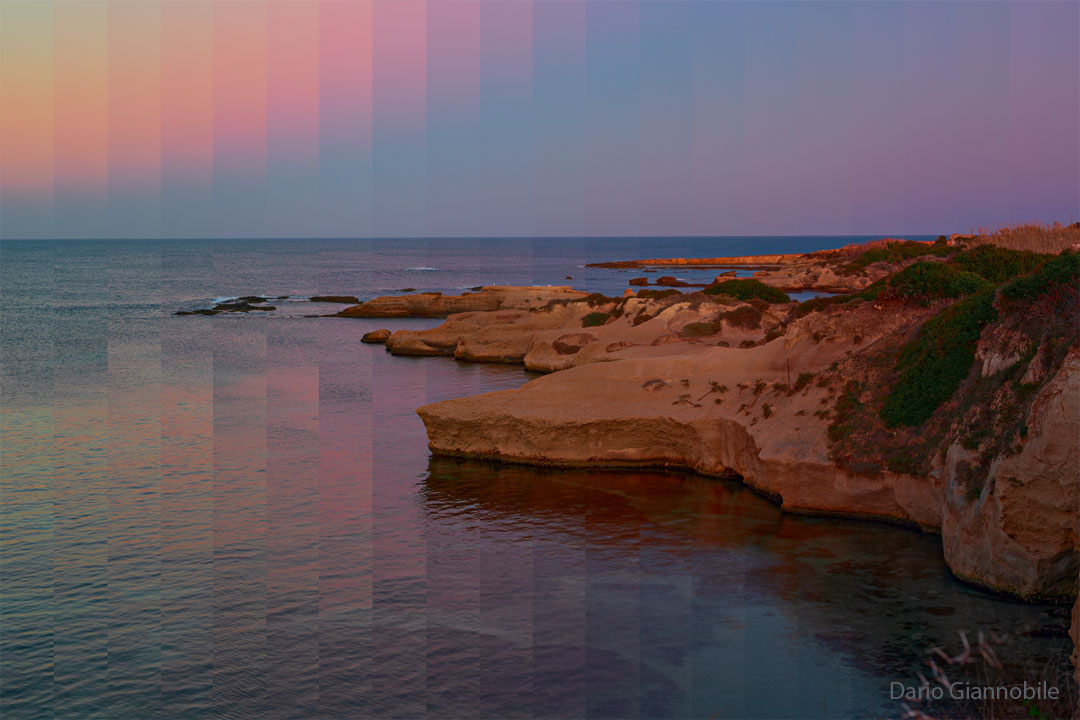안녕하세요!
디지탈노다지입니다.
미국 NASA에서 제공하는 오늘의 우주 사진을 공유합니다.
어떤 우주의 모습을 비춰줄까요?
우선, 사진부터 감상하시죠! 이 멋진 사진의 제목은 Shades of Night 입니다.
NASA에서 공식적으로 제공한 설명을 보시죠. How does the sky turn dark at night? In stages, and with different characteristic colors rising from the horizon. The featured image shows, left to right, increasingly late twilight times after sunset in 20 different vertical bands. The picture was taken last month in Syracuse, Sicily, Italy, in the direction opposite the Sun. On the far left is the pre-sunset upper sky. Toward the right, prominent bands include the Belt of Venus, the Blue Band, the Horizon Band, and the Red Band. As the dark shadow of the Earth rises, the colors in these bands are caused by direct sunlight reflecting from air and aerosols in the Earth's atmosphere, multiple reflections sometimes involving a reddened sunset, and refraction. In practice, these bands can be diffuse and hard to discern, and their colors can depend on colors near the setting Sun. Finally, the Sun completely sets and the sky becomes dark. Don't despair -- the whole thing will happen in reverse when the Sun rises again in the morning. 밤이 되면 어떻게 하늘이 어두워지나요? 단계적으로, 그리고 지평선에서 떠오르는 다른 특징적인 색상을 가지고 있습니다. 특징적인 이미지는 해가 진 후 점점 더 늦은 황혼 시간을 20개의 다른 수직 밴드로 보여줍니다. 이 사진은 지난 달 이탈리아 시칠리아의 시라큐스에서 태양과 반대 방향으로 찍은 것이다. 맨 왼쪽에는 해가 지기 전의 상층 하늘이 있다. 오른쪽으로 갈수록 눈에 띄는 띠는 금성대, 청색대, 지평선대, 적색대 등이다. 지구의 어두운 그림자가 떠오르면서 이 띠들의 색은 지구 대기의 공기와 에어로졸에서 반사되는 직사광선, 때로는 붉게 물든 석양과 관련된 다중 반사, 그리고 굴절에 의해 발생한다. 실제로 이 띠들은 확산되어 식별하기 어려울 수 있으며, 이 띠들의 색은 지는 태양 근처의 색에 따라 달라질 수 있다. 마침내 태양은 완전히 지고 하늘은 어두워진다. 절망하지 마세요 -- 아침에 다시 해가 뜨면 모든 것이 거꾸로 일어날 것입니다. 우주의 다양한 모습은 아름답습니다~
그리고 광활하며 거대합니다. 형형색색 변화하며 살아있는 듯한 느낌을 주네요~ 가볼 수는 없지만 이렇게 사진으로 볼 수 있어서 좋네요!
디지탈노다지는 더 좋은 사진과 함께 돌아오겠습니다,
남은 하루도 행복하세요~ 
'자동화정보' 카테고리의 다른 글
| Odysseus and The Dish(2024-03-01)NASA 우주사진 (0) | 2024.03.01 |
|---|---|
| Julius Caesar and Leap Days(2024-02-29)NASA 우주사진 (0) | 2024.02.29 |
| Supernova Remnant Simeis 147(2024-02-27)NASA 우주사진 (1) | 2024.02.27 |
| Martian Moon Eclipses Martian Moon(2024-02-26)NASA 우주사진 (0) | 2024.02.26 |
| A Phoenix Aurora over Iceland(2024-02-25)NASA 우주사진 (1) | 2024.02.25 |